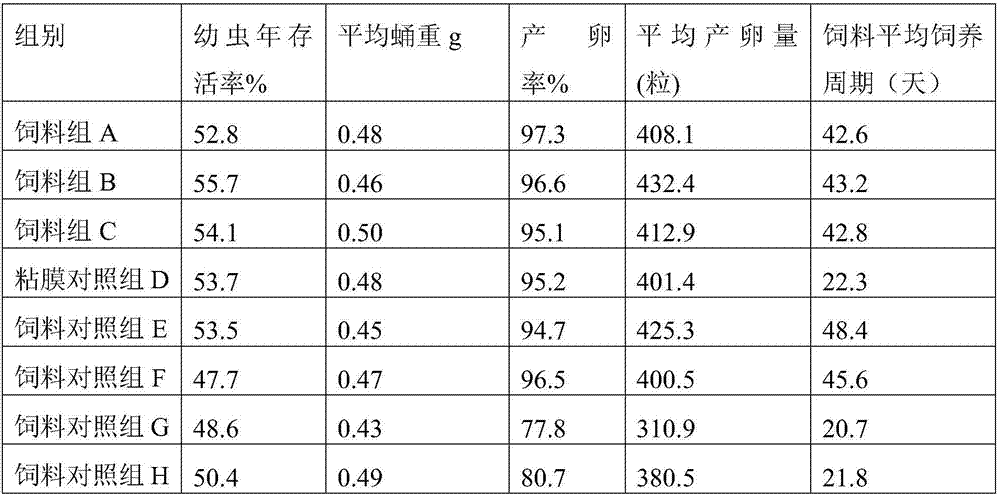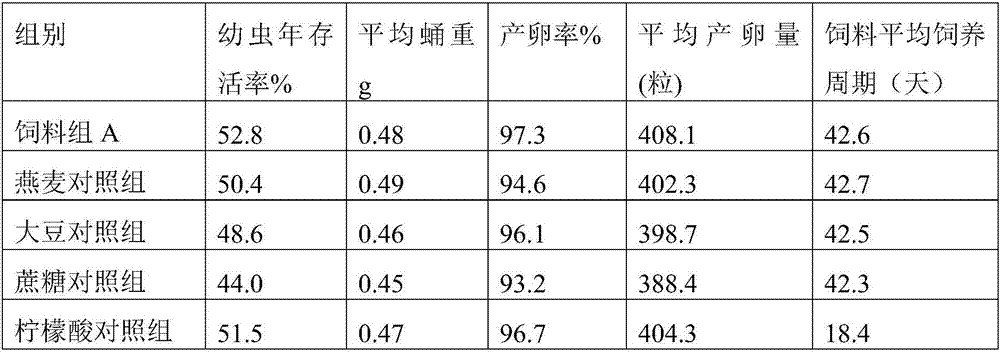Feed for cordyceps sinensis host larvae and preparation method of feed
A technology for host and feed of Cordyceps sinensis, which is applied in the field of Cordyceps sinensis host larvae feed and feeding Cordyceps sinensis host larvae, can solve problems such as the decline of Cordyceps production, and achieve the effects of promoting cultivation and improving work efficiency.
- Summary
- Abstract
- Description
- Claims
- Application Information
AI Technical Summary
Problems solved by technology
Method used
Image
Examples
Embodiment 1
[0029] The preparation of embodiment 1 bat moth larva artificial feed
[0030] In the present invention, Polygonum villosa powder and Goose velvet wilting vegetable powder are excavated from places suitable for bat moth larvae on the Qinghai-Tibet Plateau, removed impurities, fibrous roots, etc., washed with water, sliced, dried at 55°C immediately, and then crushed to 80 mesh. The above method is simple to process, and the obtained powder can retain nutrients to the greatest extent.
[0031] Prepare the feed as follows: put 100ml of distilled water in a triangular flask, add agar powder and sucrose, sterilize by high-pressure steam at 121°C for 30min, pour the hot agar solution into the beaker, and add the weighed Polygonum viburnum powder and goose down wilt Pour leek powder, oat powder, and soybean powder into a beaker, and continuously stir with a glass rod. When the temperature drops to about 55°C, add citric acid, and mechanically divide the artificial feed to grow 1.5cm...
Embodiment 2
[0040] The raising of embodiment 2 different feeds to bat moth larvae
[0041] First, after laying a layer of 0.3cm in the cultivation tray, the humidity is 55% sterile plateau soil, which is used for larvae moisturizing, and the seven treatment feed groups in Example 1 are prepared into 1.5cm particle size according to their respective methods. , put 10g of feed into a single cultivation cell, place one larva in each cell, cover it and place it in a 1 million-level clean area for breeding.
[0042] Wherein each handles and raises 100 dishes, and each cultivation dish has 4*8 cultivation grids, replaces aseptic cultivation dish, feed, aseptic plateau soil after a certain period of time, each processing gained pupa is weighed separately, and carry out After eclosion mating, the average egg laying rate and egg laying amount of females were calculated, and the feed feeding cycle corresponding to each treatment was observed.
[0043] The rearing of three larval stages was carried...
Embodiment 3
[0052] Embodiment 3 plateau feed screening
[0053] In this implementation, the inventors describe in detail the screening of highland plants for feed:
[0054] In recent years, studies have found that the host larvae of Cordyceps sinensis mainly eat the rhizome parts of different plants belonging to about 19 families and 35 genera, and they also prefer to eat plants of the genus Polygonum and Rhubarb, such as Polygonum genus Polygonum, Polygonum viburnum, and small rhubarb of the genus Rhubarb. Most of these plants grow in Tibet, Sichuan, Yunnan, Qinghai and other plateau areas, which is consistent with the distribution of host insects.
[0055] The inventor investigates their worm-raising effect from Polygonum auranthus, Polygonum villosa, Little Rhubarb, Goose down velvet, and Gastrodia elata with a relatively high annual survival rate of larvae and partial eclipse of larvae, and the results are shown in Table 2:
[0056] Table 2:
[0057] feed
[0058] Since th...
PUM
| Property | Measurement | Unit |
|---|---|---|
| Thickness | aaaaa | aaaaa |
Abstract
Description
Claims
Application Information
 Login to View More
Login to View More - R&D
- Intellectual Property
- Life Sciences
- Materials
- Tech Scout
- Unparalleled Data Quality
- Higher Quality Content
- 60% Fewer Hallucinations
Browse by: Latest US Patents, China's latest patents, Technical Efficacy Thesaurus, Application Domain, Technology Topic, Popular Technical Reports.
© 2025 PatSnap. All rights reserved.Legal|Privacy policy|Modern Slavery Act Transparency Statement|Sitemap|About US| Contact US: help@patsnap.com


